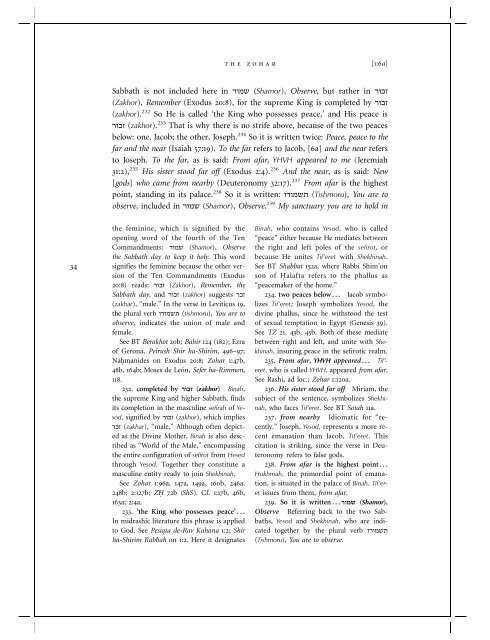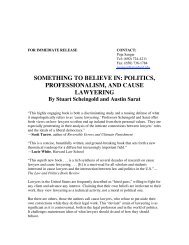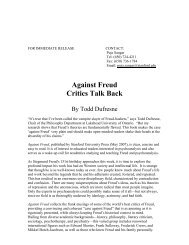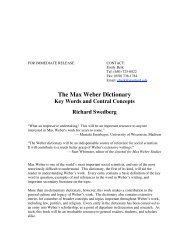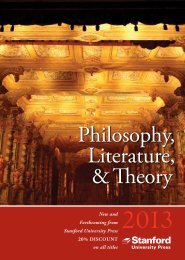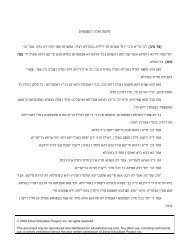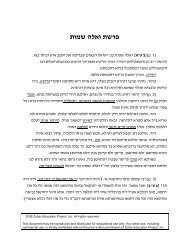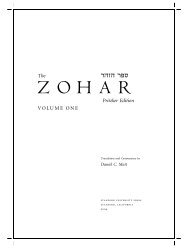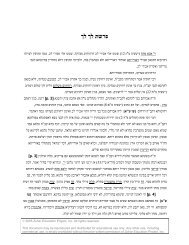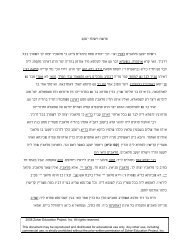Chapter 1 (PDF) - Stanford University Press
Chapter 1 (PDF) - Stanford University Press
Chapter 1 (PDF) - Stanford University Press
Create successful ePaper yourself
Turn your PDF publications into a flip-book with our unique Google optimized e-Paper software.
(zakhor). 232<br />
the zohar [1:6a]<br />
233<br />
That is why there is no strife above, because of the two peaces<br />
(zakhor).<br />
one, Jacob; the other, Joseph. 234 So it is written twice: Peace, peace to the<br />
below:<br />
and the near (Isaiah 57:19). To the far refers to Jacob, [6a] and the near refers<br />
far<br />
Joseph. To the far, as is said: From afar, YHVH appeared to me (Jeremiah<br />
to<br />
235 His sister stood far off (Exodus 2:4). 236 And the near, as is said: New<br />
31:2),<br />
who came from nearby (Deuteronomy 32:17). 237 From afar is the highest<br />
[gods]<br />
feminine, which is signified by the<br />
the<br />
word of the fourth of the Ten<br />
opening<br />
indicates the union of male and<br />
observe,<br />
female.<br />
BT Berakhot 20b; Bahir 124 (182); Ezra<br />
See<br />
Gerona, Peirush Shir ha-Shirim, 496±97;<br />
of<br />
on Exodus 20:8; Zohar 1:47b,<br />
Naḥmanides<br />
164b; Moses de LeoÂn, Sefer ha-Rimmon,<br />
48b,<br />
(zakhar), ``male.'' Although often depict-<br />
as the Divine Mother, Binah is also describeed<br />
as ``World of the Male,'' encompassing<br />
entire configuration of sefirot from Ḥesed<br />
the<br />
Yesod. Togetherthey constitute a<br />
through<br />
entity ready to join Shekhinah.<br />
masculine<br />
Zohar 1:96a, 147a, 149a, 160b, 246a,<br />
See<br />
2:127b; ZḤ 72b (ShS). Cf. 1:17b, 46b,<br />
248b;<br />
2:4a. 163a;<br />
`the King who possesses peace' . . .<br />
233.<br />
midrashic literature this phrase is applied<br />
In<br />
God. See Pesiqta de-Rav Kahana 1:2; Shir<br />
to<br />
Rabbah on 1:2. Here it designates<br />
ha-Shirim<br />
who contains Yesod, who is called<br />
Binah,<br />
eitherbecause He mediates between<br />
``peace''<br />
right and left poles of the sefirot, or<br />
the<br />
He unites Tif'eret with Shekhinah.<br />
because<br />
BT Shabbat 152a, where Rabbi Shim'on<br />
See<br />
of Ḥalafta refers to the phallus as<br />
son<br />
the home.''<br />
``peacemakerof<br />
two peaces below . . . Jacob symbo-<br />
234.<br />
Tif'eret; Joseph symbolizes Yesod, the<br />
lizes<br />
phallus, since he withstood the test<br />
divine<br />
sexual temptation in Egypt (Genesis 39).<br />
of<br />
TZ 21, 43b, 45b. Both of these mediate<br />
See<br />
right and left, and unite with Shekhinah,<br />
between<br />
insuring peace in the sefirotic realm.<br />
From afar, YHVH appeared . . . Tif'-<br />
235.<br />
who is called YHVH, appeared from afar.<br />
eret,<br />
Rashi, ad loc.; Zohar 1:120a.<br />
See<br />
His sister stood far off Miriam, the<br />
236.<br />
of the sentence, symbolizes Shekhinah,<br />
subject<br />
who faces Tif'eret. See BT Sotah 11a.<br />
from nearby Idiomatic for``recently.''<br />
237.<br />
Joseph, Yesod, represents a more re-<br />
emanation than Jacob, Tif'eret. This<br />
cent<br />
is striking, since the verse in Deu-<br />
citation<br />
refers to false gods.<br />
teronomy<br />
From afar is the highest point . . .<br />
238.<br />
Referring back to the two Sab-<br />
Yesod and Shekhinah, who are indicatebaths,<br />
togetherby the plural verb \ GZGP[<br />
is not included here in [ GP Z (Shamor), Observe, but rather in H ZGM<br />
Sabbath<br />
Remember (Exodus 20:8), forthe supreme King is completed by H ZGM<br />
(Zakhor),<br />
So He is called `the King who possesses peace,' and His peace is<br />
Z GMH<br />
standing in its palace. 238 So it is written: \ ZGP[ G (Tishmoru), You are to<br />
point,<br />
included in [ GP Z (Shamor), Observe. 239 My sanctuary you are to hold in<br />
observe,<br />
[ GP Z (Shamor), Observe<br />
Commandments:<br />
34<br />
Sabbath day to keep it holy. This word<br />
the<br />
the feminine because the otherver-<br />
signifies<br />
sion of the Ten Commandments (Exodus<br />
(Zakhor), Remember, the<br />
reads: H GM Z<br />
20:8)<br />
day, and H GM Z (zakhor) suggests H ZM<br />
Sabbath<br />
(zakhar), ``male.'' In the verse in Leviticus 19,<br />
(tishmoru), You are to<br />
plural verb \ ZGP[ G<br />
the<br />
118.<br />
completed by H GM Z (zakhor) Binah,<br />
232.<br />
supreme King and higher Sabbath, finds<br />
the<br />
completion in the masculine sefirah of Ye-<br />
its<br />
sod, signified by<br />
H<br />
GM<br />
Z<br />
(zakhor), which implies<br />
Z<br />
MH<br />
the primordial point of emanation,<br />
Ḥokhmah,<br />
is situated in the palace of Binah. Tif'eret<br />
issues from them, from afar.<br />
(Shamor),<br />
So it is written . . . [ GP Z<br />
239.<br />
Observe<br />
(Tishmoru), You are to observe.


